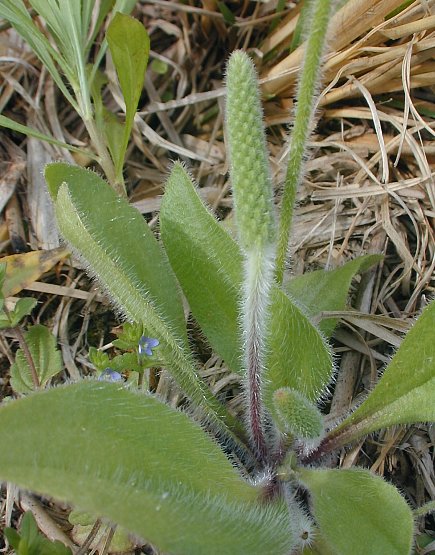Description: This plant is a winter annual. It consists of a small rosette of basal leaves, from which one or more flowering spikes develop. The basal leaves are up to 6" long and 3" across, although they are more typically about one-half this size. They can assume various shapes, including oblanceolate, obovate, and oval. The medium green leaves have 3-5 parallel veins, smooth and ciliate margins, and blunt tips; they taper gradually to winged petioles, which are often reddish. The upper surface of each leaf has white hairs, while the lower surface is woolly pubescent with longer white hairs along the veins.

The flowering
stalks are about 4-8" tall and unbranched. The upper two-thirds of each
stalk consists of a cylindrical floral spike that is densely covered
with small flowers and their bracts, while the lower one-third is naked
(lacking bracts or cauline leaves). The naked portion of each stalk is
terete, densely hairy, and often reddish toward the bottom. The flowers
are unisexual, bisexual, or sterile. Each flower is about 1/8" long; it
has a narrow corolla with 4 erect lobes and a calyx with 4 sepals. The
chaffy corolla becomes tan or brown with maturity, while the sepals are
green and hairy. The bracts of the flowers are green and hairy like the
sepals, except they are even smaller in size. The blooming period
occurs from mid-spring to early summer. The flowers are
wind-pollinated. Each fertile flower is replaced by an oblongoid seed
capsule that splits open around the middle to release its seeds. The
root system consists of a taproot. This plant spreads by reseeding
itself.
Cultivation:
Full sun, mesic to dry conditions, and sandy or rocky soil are
preferred. Because this species is a winter annual, seeds should be
planted during the late summer or early fall.
 Range
& Habitat: The native Dwarf Plantain is
occasional
to locally common in southern and central Illinois, and often absent in
northern Illinois (see Distribution
Map); it tends to be more common in sandy areas of the state.
Habitats include dry sand prairies, hill prairies, cliffs, rocky
glades, barren slopes, gravelly areas along railroads and roadsides,
sandy fields, and waste areas. This species is usually found in
disturbed areas with scant vegetation.
Range
& Habitat: The native Dwarf Plantain is
occasional
to locally common in southern and central Illinois, and often absent in
northern Illinois (see Distribution
Map); it tends to be more common in sandy areas of the state.
Habitats include dry sand prairies, hill prairies, cliffs, rocky
glades, barren slopes, gravelly areas along railroads and roadsides,
sandy fields, and waste areas. This species is usually found in
disturbed areas with scant vegetation.
Faunal Associations:
In sandy areas, where Dwarf Plantain (Plantago virginica) is known to
occur, the False Japanese Beetle (Strigoderma arboricola), also known
as the Sandhill Chafer, can be found on the floral spikes of plantains (Plantago spp.),
where it feeds on the flowers and buds. Other insects
that feed on plantains include weevils, stinkbugs, larvae of leaf-miner
flies, larvae of Tiger moths (Arctiidae), larvae of Owlet moths
(Noctuidae), and grasshoppers. The Insect Table
has a more detailed listing of these species. The seeds of
plantains
are eaten by the Greater Prairie Chicken, Northern Cardinal,
Grasshopper Sparrow, and probably other granivorous birds (Martin
et al., 1951/1961; Schwartz, 1945). Because of its hairy foliage, Dwarf
Plantain is probably less preferred as a source of food for mammalian
herbivores than other plantains.
Photographic Location:
A sandy field in Vermilion County, Illinois.
Comments:
This little plant is one of the native Plantago spp.
(plantains). It doesn't invade lawns or become a significant nuisance
unless the ground is sandy or gravelly. The basal leaves of Dwarf
Plantain are less wide than those of Plantago rugelii
(Black-Seeded Plantain) and Plantago major (Common
Plantain); these latter two species are common weeds in lawns and
paths. In sharp contrast to Dwarf Plantain, they have hairless leaves
and flowering stalks. Several other plantains in Illinois have leaves
that are more narrow than those of Dwarf Plantain; species in this
group include Plantago aristata (Bracted Plantain),
Plantago patagonica (Woolly Plantain), and Plantago
pusilla (Small Plantain). Like Dwarf Plantain, these are
native annuals that prefer dry sunny areas with sterile soil. They
differ from each other primarily in the characteristics of their
flowers and bracts.